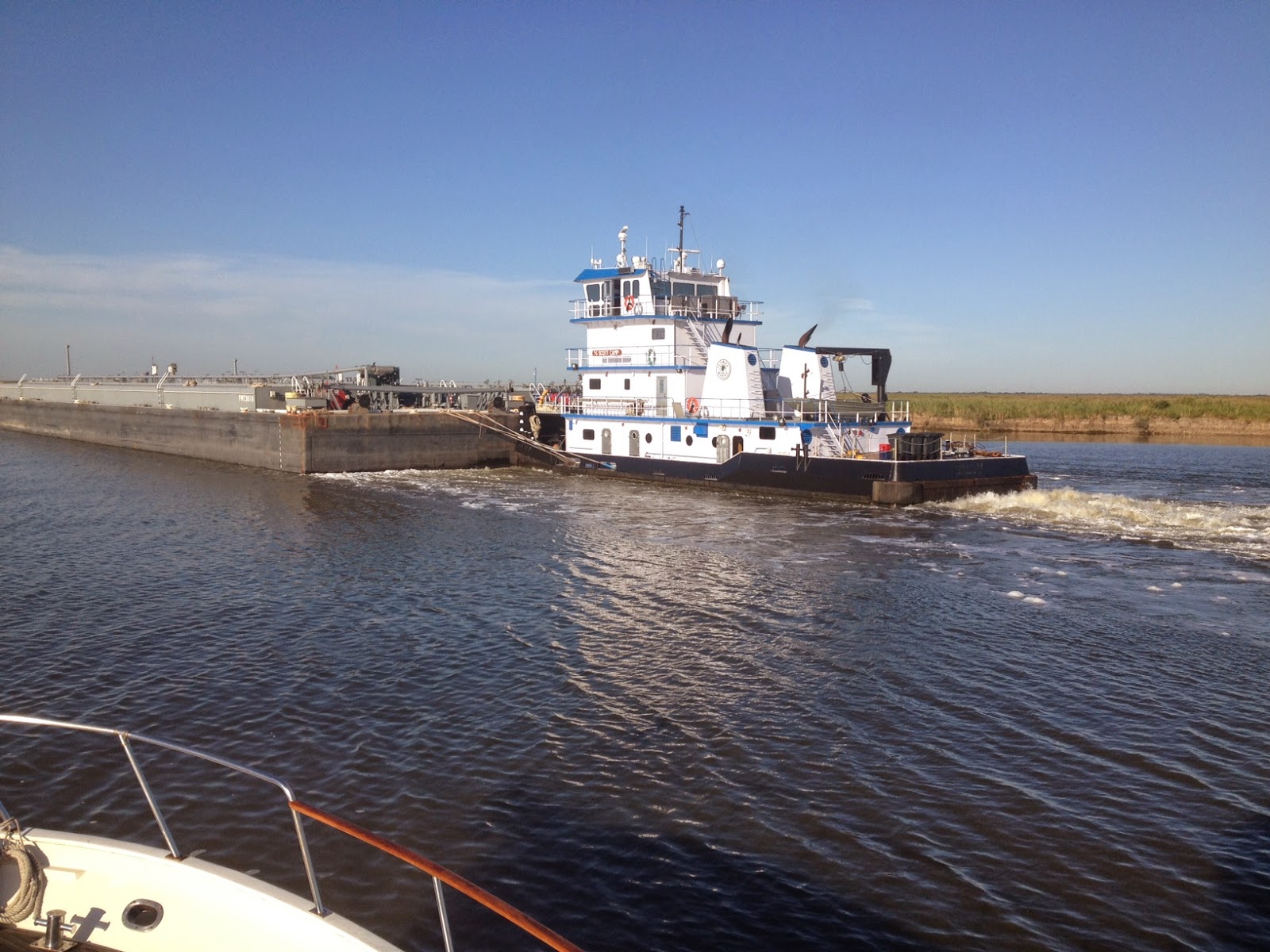It was not a long trip to Galveston (64.2 miles), but especially with shorter days this time of the year, it would really have been too long a day to have gone all of the way home today. We will save the next 28.7 miles for tomorrow... Of course, we did start the day at sunrise as the time stamp of 7:31 am on the photo at the right indicates. There is some good news here since in two more days we will lose Daylight Savings Time, and then this picture would have been taken at 6:33 am... Somehow that knowledge does not really make me feel any better. A sunrise departure is still too early! We were anchored about 1 mile off the waterway up the channel in the foreground. There were as many as three tows anchored to the north (left in the photo) of us during the night and one anchored to the right. As luck would have it, two of the four tows decided to leave at sunrise also.
The Gulf Intra Coastal Waterway and these side channels all seem to have good holding for our CRQ plow anchor. The mud is black (i.e. has a high content of organic matter), and as a result, the smelly mud needs to be washed off the anchor chain before it goes into the chain/rope locker under the windlass. The picture at the left shows the Admiral hosing down the chain to wash off the mud. As you can see in the photo, the Admiral is warmly dressed for the cool morning air (about 58F). Our "official" start time was 7:39 am when the anchor was locked into place.
In the early morning air, we saw some unusual sights, such the feral hogs along the bank in the picture at the right. One of the things that we have both loved about this trip is that every time you think you have seen it all then you see something new or different.
Continuing on the theme of new and/or different, we also saw these two "Texas Canaries" along the shore. Of course, these canaries sing something that sounds more like "hee haw" or whatever it is that donkeys really sound like. They seemed to take no notice as we passed by them while they munched on the grass.
We also had a visitor on the bow rail for a few minutes. Of course, we have seen many birds, but this is the first one that I remember seeing land while under way and stay. Clearly, we were not a port of refuge for the bird since we were only a few hundred feet from shore... Still it was a day for strange sightings given that this is Day 2-354 and these are not exactly exotic animals.
We continued to see many tows again today. The picture at the left shows a deck barge loaded with "stuff" headed for a new refinery near Lake Charles (?). This is the second tow headed east that we passed loaded with towers like this. According to the chatter on the radio, this tow is headed for a new terminal near Lake Charles.
We also passed 7 tows headed in our direction. Several of the tows, like this one, looked like they had just been repainted. We always try to wave at the operators, and if we are passing one, we always try to thank them on the radio. Today must have been a good day in general for them since they were very chatty on the VHF radio.
We also went by a pelican convention that was taking place on a narrow spit of dredge spoil along the north side of the channel (picture at left). The white and brown pelicans were really packed together tightly. We do not usually see many white pelicans around Galveston Bay during the winter so maybe the white pelicans are headed west and south along the coast. At this point we were travelling along the southern boundary of Galveston Bay. The tows in the background are actually in the Houston Ship Channel in Galveston Bay. For reference, The Bolivar peninsula is behind us in the picture, and it actually forms a physical barrier separating the Gulf of Mexico from Galveston Bay. The Bolivar Peninsula is generally very low and narrow. It is (or was) a popular area for summer cottages, but it was heavily damaged when the storm surge from Hurricane Ike swept over the peninsula in 2008.
The Houston Ship Channel goes between the western end of the Bolivar Peninsula and Galveston Island. The two white buildings and the black lighthouse are what is called the Bolivar Lighthouse. The lighthouse is a classic 19th Century cast iron lighthouse that was made in Pittsburgh, PA and shipped here by barge down the Ohio and Mississippi Rivers.
The traffic really picked up as we approached the Houston Ship Channel (picture at left). The Houston Ship Channel is the second busiest in the World, and the "intersection" where it crosses the Gulf Intra Coastal Waterway is just bonkers. There are tows going into and out of the ship channel as well as tows crossing and ship channel. Within a mile or so both north and south there are other channels that lead into Galveston and into Texas City. Throw in numerous shrimp boats and between 3 and 5 large car ferries that run from Bolivar Peninsula to Galveston. Well, you get the picture. It is a very busy stretch of water...
We docked at the Galveston Yacht Basin without any problems, and we managed some time to relax. Our friend, Debbie S., picked us up to take us to historic downtown Galveston for dinner (picture at left). We had great seafood and got caught up over dinner. Debbie dropped us off back at Lucky Us about 9:00 pm, and that was it for the day...











No comments:
Post a Comment